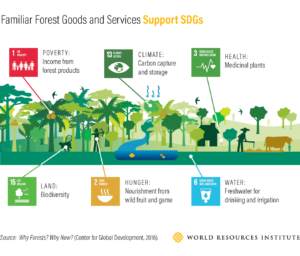In 2024, the focus on sustainable forestry practices has never been more crucial, and community-based forest management (CBFM) is emerging as a leading solution to environmental and socio-economic challenges. This approach not only addresses ecological sustainability but also enhances local livelihoods, fosters community engagement, and creates a model for effective forest conservation. This article explores how CBFM is transforming forestry practices and shaping a more sustainable future.
Understanding Community-Based Forest Management
Community-Based Forest Management (CBFM) refers to the process where local communities actively participate in the planning, implementation, and monitoring of forest management activities. Unlike traditional top-down forest management models, CBFM emphasizes the involvement of local stakeholders in decision-making processes, acknowledging their role in both the conservation and utilization of forest resources.
The Rise of CBFM in 2024
In recent years, the global emphasis on sustainability has led to a reevaluation of traditional forest management approaches. The growing recognition of the importance of local knowledge and community involvement has given rise to CBFM as a viable alternative. As we move further into 2024, several key factors are driving this shift:
- Increased Awareness of Environmental Challenges: Climate change, deforestation, and biodiversity loss are pressing issues that require innovative solutions. CBFM offers a way to address these challenges by leveraging local knowledge and fostering stewardship.
- Policy and Legal Support: Governments and international organizations are increasingly recognizing the value of CBFM. Policies and legal frameworks are being developed to support community involvement in forest management, providing communities with the tools and authority they need to manage their resources sustainably.
- Technological Advancements: Advances in technology, such as Geographic Information Systems (GIS) and remote sensing, are enhancing the ability of communities to monitor and manage forest resources effectively. These technologies enable better data collection and decision-making, making CBFM more efficient and impactful.
Benefits of Community-Based Forest Management
The benefits of CBFM extend beyond environmental conservation. Here are some of the key advantages:
- Enhanced Forest Conservation: Communities often have a deep understanding of their local ecosystems and are motivated to protect them. By involving local people in forest management, CBFM helps ensure that conservation efforts are more effective and aligned with local needs.
- Improved Livelihoods: CBFM can provide economic opportunities for local communities through sustainable forest use, such as non-timber forest products, eco-tourism, and sustainable timber harvesting. This can lead to improved livelihoods and economic stability.
- Strengthened Social Cohesion: Collaborative forest management fosters a sense of ownership and responsibility among community members. This can strengthen social ties and enhance community resilience.
- Conflict Resolution: By involving local stakeholders in decision-making, CBFM helps address conflicts that may arise between different forest users. This collaborative approach promotes more equitable and transparent management practices.
Case Studies of Successful CBFM Initiatives
Several examples around the world illustrate the success of CBFM:
- The REDD+ Program in Nepal: The Reduced Emissions from Deforestation and Forest Degradation (REDD+) program in Nepal involves local communities in forest management and conservation activities. This initiative has led to significant reductions in deforestation rates and improved forest health.
- Community Forest Management in Tanzania: In Tanzania, community forest management projects have empowered local communities to take charge of forest conservation. These initiatives have led to increased forest cover, enhanced biodiversity, and better livelihoods for local residents.
- The Amazon Conservation Team in Colombia: The Amazon Conservation Team works with indigenous communities in Colombia to protect the Amazon rainforest. Through CBFM, these communities have been able to implement sustainable practices that protect both their cultural heritage and the environment.
Challenges and Solutions
While CBFM offers numerous benefits, it also faces several challenges:
- Capacity Building: Many communities may lack the technical knowledge or resources needed for effective forest management. Capacity-building programs and technical assistance are essential to address this issue.
- Land Tenure Issues: Insecure land tenure can hinder the success of CBFM initiatives. Clear and secure land rights are crucial for communities to manage their forest resources effectively.
- Funding and Resources: Adequate funding and resources are necessary to support CBFM initiatives. Governments, NGOs, and international organizations play a key role in providing financial and technical support.
- Balancing Conservation and Development: Striking a balance between conservation goals and developmental needs can be challenging. It is important to ensure that forest management practices are both environmentally sustainable and economically viable.
Future Directions for CBFM
Looking ahead, several trends are likely to shape the future of CBFM:
- Integration with Climate Change Strategies: As the impacts of climate change become more pronounced, CBFM will increasingly be integrated into broader climate change mitigation and adaptation strategies.
- Greater Emphasis on Indigenous Knowledge: Indigenous communities possess valuable traditional knowledge that can enhance forest management practices. Recognizing and incorporating this knowledge will be crucial for the success of CBFM.
- Expansion of Collaborative Networks: Building networks and partnerships among communities, governments, and organizations will strengthen CBFM initiatives and improve their effectiveness.
- Focus on Equity and Inclusivity: Ensuring that all members of the community, including marginalized groups, have a voice in forest management decisions will be important for achieving equitable and sustainable outcomes.
Conclusion
Community-Based Forest Management represents a powerful approach to achieving sustainable forestry in 2024. By empowering local communities, CBFM not only enhances forest conservation but also improves livelihoods, fosters social cohesion, and supports sustainable development. As we move forward, continued support for CBFM initiatives, along with addressing the associated challenges, will be key to ensuring a more sustainable and equitable future for forests and the communities that depend on them.



